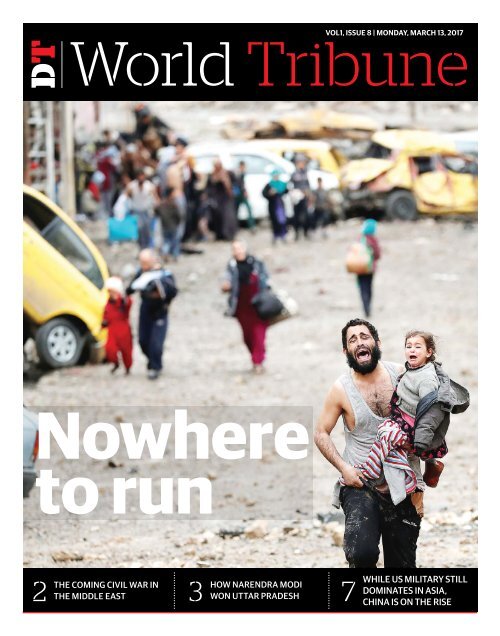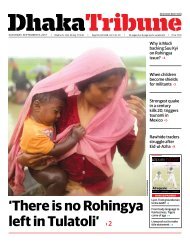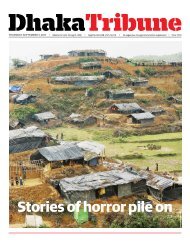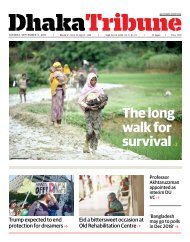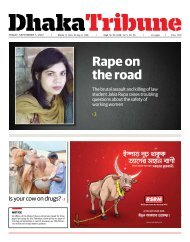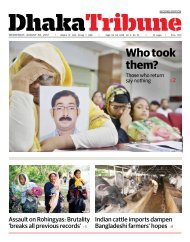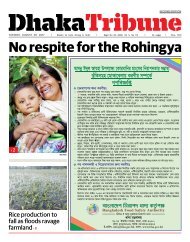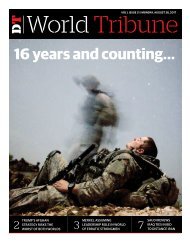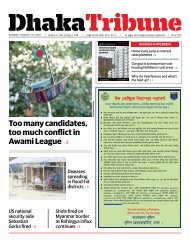You also want an ePaper? Increase the reach of your titles
YUMPU automatically turns print PDFs into web optimized ePapers that Google loves.
DT<br />
VOL1, ISSUE 8 | Monday, <strong>March</strong> <strong>13</strong>, <strong>2017</strong><br />
<strong>World</strong> Tribune<br />
Nowhere<br />
to run<br />
The coming civil war in<br />
2 the Middle East<br />
3<br />
How Narendra Modi<br />
won Uttar Pradesh<br />
While US military still<br />
dominates in Asia,<br />
7 China is on the rise
2<br />
Monday, <strong>March</strong> <strong>13</strong>, <strong>2017</strong><br />
DT<br />
Analysis<br />
The coming civil war in the Middle East<br />
The destabilisation of the Islamic world is the grand strategy of the US in order to eliminate any<br />
alternative poles to its hegemony<br />
• Hakan Karakurt<br />
When the Cold War ended peacefully<br />
in 1989 with the collapse of<br />
Communist bloc led by the Soviet<br />
Union (USSR), the hope to build a<br />
just, secure and democratic world<br />
rose in the minds of many people.<br />
Unfortunately the reality was<br />
just the opposite. Although the US<br />
promised Russians that if the USSR<br />
peacefully ended the Cold War, the<br />
West would not advance East even<br />
one centimetre, twelve ex-Communist<br />
countries joined Nato, and US<br />
and UK troops have been deployed<br />
to the Baltic countries, Poland and<br />
Romania. Even twin brothers, Russians<br />
and Ukrainians, began to fight<br />
against each other in Ukraine due to<br />
the provocations of the US and EU<br />
to isolate Ukraine from the sphere<br />
of the Slavic world and incorporate<br />
her into Western Bloc as a buffer<br />
zone and exploit the cheap labour,<br />
good quality commodities, and<br />
45m market for EU export products.<br />
The grand strategy of the US is<br />
always to hinder any pole that can<br />
empower Heartland, Eurasia. Assuming<br />
itself to be invincible and<br />
the sole lord of the world, the US<br />
chose the Islamic world as the second<br />
target that must be weakened.<br />
Unsurprisingly, the US lost no time,<br />
and 434 days after the fall of the<br />
Berlin Wall, it invaded Iraq in the<br />
first days of 1991.<br />
Prototype civil war<br />
Currently, the struggle in Iraq between<br />
Sunni and Shia Arabs and<br />
Kurds is ongoing. Especially after<br />
the recapturing of Mosul from IS, the<br />
fate of the country will be clearer. In<br />
the South, Shia Arabs are supported<br />
by Iran, while Sunni Arabs are not<br />
represented in the Iraq government<br />
and to some extent Turkey and Saudi<br />
Arabia try to represent their interests.<br />
Kurds are divided also. Barzani<br />
Kurds are supported by Turkey<br />
while the Talabani side is closer to<br />
Iran. Unfortunately, in such a separated<br />
situation, Iraq is far from unity<br />
and stabilisation in the near future.<br />
The Syrian civil war was the<br />
most devastating and bloodiest<br />
scene of the so-called Arab Spring.<br />
Not only the local people of Syria-<br />
Sunni Arabs, Allewites (close to<br />
Shias), Kurds, and Turkomans - but<br />
also Turkey, Iran, and Saudi Arabia<br />
directly or via proxies engaged and<br />
fought each other in the Syrian civil<br />
war. Though the ceasefire is obeyed<br />
generally in the country between<br />
moderate opponents and the Assad<br />
regime, the fight against IS is ongoing<br />
and the future of the country is<br />
unclear as the tension and clashes<br />
continue between Turkey and Syrian<br />
Kurds, Turkey and Russia’s direct<br />
military interventions, and the<br />
influx of foreign warriors such as<br />
Shia Hezbollah, Salafi Al Nusra. The<br />
current situation in Syria is similar<br />
to Iraq in terms of territorial disunity<br />
and destabilisation.<br />
The Yemeni Civil War relying<br />
on sectarian differences between<br />
Sunni and Shia Arabs has divided<br />
the country, and Saudi Arabia with<br />
its Arab allies has interfered directly.<br />
There is no hope for ending the<br />
conflict in the short run, and it is<br />
the scene of a war between Saudi<br />
Arabia and Iran.<br />
Furthermore, Pakistan and Lebanon<br />
are other unstable countries<br />
where Sunni-Shia clashes may easily<br />
increase to a bloodier degree. In<br />
Pakistan, suicide bombings occur<br />
between Sunnis and Shias and in<br />
Lebanon Shias have the armed organisation<br />
Hezbollah. While Hezbollah<br />
is supported by Iran, Sunni<br />
Muslims are supported by Turkey<br />
and Saudi Arabia. If the civil war in<br />
the Islamic world spreads to a greater<br />
area, Israel, India, Azerbaijan, and<br />
Armenia can be other candidates to<br />
be involved in military clashes.<br />
Consequently in Iraq, Syria, and<br />
Yemen, the core of the Islamic world<br />
in terms of ethnicity and sects (Arabs,<br />
Turks, Persians and Kurds and<br />
Sunnis and Shias) either directly or<br />
via proxies are at war against each<br />
other. Unfortunately, if the main<br />
actors of the Islamic world do not<br />
change their policies against each<br />
other, the ongoing battles are only<br />
prototypes and signal a great civil<br />
war in the Islamic world. The great<br />
civil war in the Islamic world will be<br />
not via proxies such as in Iraq, Syria<br />
and Yemen, but direct and conventional,<br />
i.e. regular armies and devastating<br />
armaments will be used. War<br />
will overwhelm and ruin the Middle<br />
East and Islamic world.<br />
The Syrian civil war was the most devastating and bloodiest scene of the so-called<br />
Arab Spring. Not only the people of Syria, but also Turkey, Iran, and Saudi Arabia<br />
directly or via proxies engaged and fought each other in the Syrian civil war<br />
Possible battlefields<br />
Saudi and Gulf Kingdoms versus<br />
Iran: The Sunni Arab Kingdoms-<br />
United Arab Emirates, Qatar, Bahrain,<br />
Kuwait, and Oman, act together<br />
under the Gulf Cooperation Council<br />
(GCC) led by Saudi Arabia. GCC<br />
countries have close military and<br />
political ties with the US, UK, and<br />
Turkey. Although they invest heavily<br />
in armaments, they need foreign<br />
military support against Iran. In addition<br />
to US and UK military bases in<br />
GCC, Turkey established a military<br />
base in Qatar last year.<br />
GCC kingdoms are in a defensive<br />
position against Iran currently.<br />
Iran’s military power solely based<br />
on local sources may easily crush<br />
GCC countries. Incidents in Iraq,<br />
Syria and Yemen are in favour of<br />
Iran, and GCC countries are on the<br />
losing side regionally. Iran’s operational<br />
military capacity and capability<br />
via proxies is another factor<br />
that threats GCC countries where<br />
considerable Shia populations live.<br />
Hezbollah in Lebanon and Syria<br />
and Shia militias in Iraq are acting<br />
as semi-professional armies. Although<br />
the GCC mainly rely on US<br />
and UK military assistance, Turkey<br />
becomes an ally against Iran due to<br />
increasing tension between Turkey<br />
and Iran. On the other hand, the<br />
GCC try to incorporate other Arab<br />
and African Muslim Sunni countries<br />
under the umbrella of an Islamic<br />
Army against Iran.<br />
Turkey versus Iran: Turkey is<br />
struggling against the Kurdish separatist<br />
PKK since 1984. After the US<br />
military intervention in Iraq in 1991,<br />
Kurds in the North of Iraq declared<br />
autonomy. Turkey firstly perceived<br />
the Iraqi Kurds as a threat to her territorial<br />
unity, but later Turkey and<br />
Iraq Kurds began to cooperatively<br />
act against Shias in Iraq. Turkey<br />
treated Iraq’s Kurds as a buffer to<br />
Shia Arabs and Iran’s influence in<br />
Iraq. On the other hand, Iraqi Kurds<br />
regard Turkey as an ally for their<br />
existence and an economic partner.<br />
After the Syrian Civil War, the<br />
PKK-linked YPG began to dominate<br />
the Syrian Kurds in Northern Syria.<br />
Unlike Iraqi Kurds, Syrian Kurds<br />
have close linguistic and kinship<br />
ties with the Kurds living in the<br />
south-eastern regions of Turkey.<br />
Moreover the US has let the YPG<br />
rule the Sunni Arab-populated parts<br />
of Syria once ruled by IS. Therefore,<br />
in addition to her territorial unity<br />
concerns, Turkey regards the US<br />
and Iran’s efforts as an attempt to<br />
found a Kurdish and Shia belt in<br />
Syria and Iraq to break the ties of<br />
Sunni Turks and Sunni Arabs. The<br />
historical ties between Turks and<br />
Sunni Arabs date back to the time of<br />
the Ottoman Empire.<br />
Furthermore both Turkey and<br />
Iran have Kurdish minority problems<br />
that are not solved yet. On the<br />
other hand, 20% of the population of<br />
Iran living in the northern provinces<br />
are Azerbaijani Turks who are the<br />
same nation as Turkey’s Turks. In a<br />
clash between Turkey and Iran, their<br />
attitude towards this sect and ethnicity<br />
and choice will be very crucial<br />
determining the result of war.<br />
Lebanon scenario: Lebanon,<br />
composed of Sunni and Shias Muslims<br />
as well as Christians, and internal<br />
politics based on sharp religious<br />
and sectarian identities, is a perfect<br />
scene where harsh clashes could take<br />
place between Sunnis and Shias. Refugees<br />
from Palestine and Syria, Syrian<br />
and Israel occupation in the last<br />
two decades, Hezbollah’s presence<br />
and its active interference in the Syrian<br />
Civil War all add to the complexity<br />
of the country. Iran’s support for<br />
Hezbollah against Israel and Sunni<br />
opponents, Turkey and Saudi Arabia’s<br />
backing for Sunni Lebanese Arabs<br />
and Palestinian refugees, Israel’s<br />
security concerns and military operations<br />
against both Hezbollah and<br />
Palestinian armed groups can easily<br />
draw the country into the civil war in<br />
the Islamic <strong>World</strong>.<br />
Azerbaijan scenario: “The same<br />
nation, two countries” is the slogan<br />
of Turks in Turkey and Azeri Turks<br />
in Azerbaijan which expresses the<br />
degree of close ties between Turkey<br />
and Azerbaijan. On the other hand,<br />
“the same nation but different sect”<br />
is the differentiating point in Turkey-Azerbaijan<br />
relations. If Turkey<br />
initiates a nationalistic revolt in<br />
South Azerbaijan that is part of Iran,<br />
then Azeri Turks have to choose<br />
either ethnicity or their Shia sect.<br />
Their choice is extremely important<br />
to determining the fate of the war<br />
between Turkey and Iran. In such a<br />
situation, Armenia could enter the<br />
war against Azerbaijan either as an<br />
ally of Iran against Turks, or just to<br />
exploit the war conditions to consolidate<br />
her military presence in Nagorno-Karabakh<br />
in Azerbaijan. •<br />
Hakan Karakurt is a Turkish researcher,<br />
and columnist. He is a political<br />
analyst with a focus on contemporary<br />
international politics and the politics of<br />
the Middle East.
Analysis<br />
3<br />
Monday, <strong>March</strong> <strong>13</strong>, <strong>2017</strong><br />
DT<br />
How Narendra Modi won Uttar Pradesh<br />
• Tribune Desk<br />
Make no mistake. The BJP win in<br />
Uttar Pradesh is a defining moment<br />
in Indian democracy.<br />
In the past 25 years, never has<br />
a party so decisively controlled<br />
the levers of power in both Delhi<br />
and UP, home to 200 million and<br />
the heart of Indian politics. Rarely<br />
has a party been able to expand its<br />
social base, in such quick time, in<br />
such an unprecedented manner,<br />
across Hindu castes, reports the<br />
Hindustan Times.<br />
And not since the 1960s has a<br />
party exercised such dominance<br />
in national politics. The BJP was<br />
strong in the west, it was expanding<br />
in the east, but it did not have<br />
a state in the core heartland, from<br />
Delhi all the way to West Bengal,<br />
even though it was seen as a cowbelt<br />
party. That has now been addressed<br />
— and how. And that is really<br />
the big question.<br />
How did the BJP win UP?<br />
Modi ki sarkar<br />
Travelling on the ground, it is astonishing<br />
to see the admiration Narendra<br />
Modi evokes. Modi travelled in<br />
the aftermath of the decision on demonetisation,<br />
expecting to find anger,<br />
but saw people — in some of the<br />
poorest districts of UP — hailing him.<br />
Voters said he had delivered on what<br />
he promised, that he had taken on<br />
the rich and corrupt, that the gains<br />
accrued from the exercise would be<br />
eventually transferred to the poor.<br />
The enthusiasm for demonetisation<br />
in itself subsided in subsequent<br />
months, but the faith in Modi<br />
did not. From Bareilly to Balia,<br />
from Meerut to Gorakhpur, from<br />
Shravasti to Jhansi, we found voters<br />
who gave a definite answer to<br />
who would they vote for.<br />
The 60% formula<br />
The 60% formula is working,” said<br />
a key BJP leader, sitting in Varanasi,<br />
in the <strong>final</strong> lap of the elections.<br />
The BJP assumed that Muslims,<br />
and a majority of Yadavs and Jatavs<br />
would not vote for the party. This<br />
would leave 55-60% of the electorate<br />
for the BJP to target. And in<br />
order to do this, the party had to expand<br />
its social base.<br />
The BJP has always been most<br />
successful in UP when it has constructed<br />
a coalition of upper castes<br />
and non-Yadav OBCs (other backward<br />
classes). Kalyan Singh was a<br />
product of this alliance, within the<br />
broader Hindutva umbrella. And it<br />
is no surprise that the last time the<br />
BJP won an outright majority in the<br />
state was on the basis of this alliance.<br />
That collapsed in the mid- to<br />
late-90s.<br />
In 2014, it reappeared. Modi’s<br />
OBC identity, besides other factors,<br />
struck a chord with the state’s backward<br />
communities. The party’s upper<br />
caste base stayed with it. And<br />
Indian Prime Minister Narendra Modi and leader of the Bharatiya Janata Party (BJP) gestures during a roadshow in support of their state assembly election party<br />
candidates in Varanasi on <strong>March</strong> 4<br />
AFP<br />
Dalit sub communities too drifted<br />
to the BJP.<br />
This is what the party had to replicate<br />
in the state.<br />
And to do this, it embarked on a<br />
three-pronged strategy — appoint<br />
someone from a non-Yadav OBC<br />
community (Keshav Prasad Maurya)<br />
as state president; appoint office<br />
bearers in districts from these<br />
communities; and give them the<br />
highest number of tickets that the<br />
party has yet awarded to provide<br />
representation. This was ambitious<br />
social engineering, for it ran the<br />
risk of alienating the party’s older<br />
supporters. Amit Shah and the party’s<br />
organisation man in UP, Sunil<br />
Bansal, took the risk. It paid off.<br />
The party also expanded in rural<br />
areas. It put up candidates in<br />
panchayat elections last year. Out<br />
of 3,100 seats, it contested in 2,800<br />
and won only 300. But in the process,<br />
it created a pool of active leaders<br />
at the rural level across districts.<br />
They also had the most risky<br />
ticket distribution exercise in the<br />
party’s history in UP so far.<br />
With this ambitious but extremely<br />
careful and meticulously<br />
planned strategy, the BJP has not<br />
only won this election. It has transformed<br />
its own party’s character,<br />
and has created a generation of<br />
leaders who will stand the party in<br />
good stead for years to come.<br />
The Hindu card<br />
But Modi’s brand and the careful<br />
construction of multi-caste alliances<br />
would probably not have been<br />
enough. The party also carefully<br />
played the Hindu card.<br />
It is difficult for the BJP to win an<br />
election in states with a substantial<br />
Muslim presence — for the simple<br />
reason that it starts from a minus 20<br />
disadvantage. It has to rely on the<br />
rest of the electorate. To do this, it<br />
has to be internally inclusive of Hindu<br />
castes and since it did not give<br />
any tickets to Muslims, it had room<br />
to do so in UP.<br />
It also has to inevitably infuse its<br />
campaign with a flavour of communal<br />
polarisation.<br />
There was latent resentment<br />
among many Hindu communities at<br />
what they perceived as the administration’s<br />
pro-Muslim tilt. There<br />
was also a degree of annoyance at<br />
both the alliance and the BSP’s efforts<br />
to woo Muslims and make that<br />
the centre piece of their respective<br />
campaigns. This provided enough<br />
room to the BJP to construct the<br />
image of other parties as pandering<br />
to the minorities.<br />
Ironically, the Muslim vote itself<br />
— these results indicate — appears to<br />
have split between the alliance and<br />
the BSP. Or even if it has gone largely<br />
to the alliance, it was not able to<br />
<strong>supplement</strong> it with other parties.<br />
This holds a lesson for “secular parties”<br />
who peg their electoral prospects<br />
only on Muslim consolidation.<br />
And so mix of the Modi magic,<br />
careful caste management and social<br />
engineering, a risky but smart<br />
Source: TOI<br />
ticket distribution strategy, the<br />
use of the Hindu card, and errors<br />
by the opposition has catapulted<br />
the BJP to power in Uttar Pradesh.<br />
The verdict will redefine Indian<br />
politics. •
4<br />
Monday, <strong>March</strong> <strong>13</strong>, <strong>2017</strong><br />
DT<br />
Week in Review<br />
<strong>March</strong> 6<br />
Philippine police ‘reload’, rejoin drug war<br />
The Philippine police chief said Monday his forces had “reloaded”<br />
and were back fighting their president’s deadly war on drugs, just<br />
over a month after they were withdrawn because of widespread<br />
corruption.<br />
President Rodrigo Duterte said in late January he had suspended<br />
all police from his crackdown on illegal drugs, which has claimed<br />
more than 6,500 lives, after describing them as “rotten to the core”.<br />
National police chief Ronald Dela Rosa said Monday reforms<br />
had been implemented to ensure there was no repeat of previous<br />
problems, which included anti-drugs officers kidnapping and murdering<br />
a South Korean businessman.<br />
Philippine authorities had originally named the drug war “Double<br />
Barrel”, in a reference to a two-pronged strategy of police operations<br />
on the streets while also focusing on “high value” targets.<br />
“Today we are going to relaunch the war on drugs, we’ve relaunched<br />
our project: Double Barrel Reloaded,” Dela Rosa said at a<br />
speech at national police headquarters in Manila.<br />
AFP<br />
<strong>March</strong> 8<br />
Indian court makes<br />
rare conviction against<br />
Hindu radicals<br />
An Indian court Wednesday handed down a rare guilty verdict<br />
against three Hindu radicals over a shrine bombing,<br />
but cleared the alleged mastermind of the attack initially<br />
blamed on Islamist groups.<br />
Devendra Gupta and Bhavesh Patel were convicted in a<br />
special court in Rajasthan over their roles in the 2007 bombing<br />
of Ajmer shrine, one of the holiest sites of Islam in India.<br />
A third man, who was shot dead in the months after the<br />
attack, was found guilty posthumously.<br />
The trio was convicted of charges related to explosives<br />
and conspiracy to commit unlawful acts over the strike that<br />
left three dead and at least 15 injured, the men’s lawyer Jagdish<br />
Rana told reporters outside the Jaipur court.<br />
Their sentences will be handed down on <strong>March</strong> 16.<br />
AFP<br />
<strong>March</strong> 7<br />
Europe launches fourth Earth<br />
monitoring satellite<br />
Europe launched a fourth satellite Tuesday for its Copernicus Earth-monitoring project to track<br />
changes in forest cover and air pollution, the European Space Agency (ESA) announced.<br />
The 1.1-tonne, “colour-vision” Sentinel-2B satellite blasted off on a Vega rocket from Europe’s<br />
space port in Kourou, French Guiana, overnight, and was successfully placed in Earth orbit, it said.<br />
In about three days, controllers will start calibrating instruments to commission the satellite,<br />
which is to start operations in three to four months.<br />
“With this launch we are taking another step toward advancing the Copernicus programme,<br />
which is the most sophisticated Earth observation system in the world,” ESA director general Jan<br />
Woerner said in a statement. Two more satellites are to follow in the coming months.<br />
Sentinel-SB, a twin of Sentinel-2A launched in June 2015, will zoom in on changes in the Earth’s<br />
land mass and coastal zones, forest cover and pollution in lakes and coastal waters, for example.<br />
Between them, the Sentinel-2 pair will cover the Earth’s entire surface in five days. They are<br />
placed in the same orbit, on opposite sides of the planet, 180 degrees apart.<br />
“Each Sentinel-2 satellite carries an innovative high-resolution multispectral camera with <strong>13</strong><br />
spectral bands for a new perspective of land and vegetation,” the agency said.<br />
<strong>March</strong> 10<br />
Chemical watchdog condemns<br />
VX use in Kim murder<br />
The world’s chemical watchdog Friday condemned the use<br />
of the deadly VX nerve agent in the assassination of North<br />
Korean leader Kim Jong-Un’s half-brother last month.<br />
The Organisation for the Prohibition of Chemical Weapons<br />
(OPCW) said its executive council “unequivocally condemned<br />
the use of any chemical weapon by anyone under<br />
any circumstances.”<br />
The council, made up from 40 member states, called “for<br />
those responsible for the use of chemical weapons to be held<br />
accountable.” It also asked the OPCW’s director general Ahmet<br />
Uzumcu to “provide technical assistance upon request<br />
from Malaysian authorities for its national investigation.”<br />
“The council underscored its deep interest in receiving<br />
and considering the official results of the investigation” once<br />
completed by Malaysia.
Week in Review 5<br />
The colours of Holi<br />
DT<br />
Monday, <strong>March</strong> <strong>13</strong>, <strong>2017</strong><br />
The festival of colors, a celebration of the vibrancy of spring, fertility, love and the triumph of<br />
good over evil, has inspired movies, music, and a plethora of whitewashed imitations. Students<br />
of Rabindra Bharati University blow colour powder during Holi celebrations inside the university<br />
campus in Kolkata on <strong>March</strong> 9<br />
reuters<br />
<strong>March</strong> 11<br />
Native Americans march on White House over Dakota pipeline<br />
Native American groups staged a march<br />
to the White House Friday against the<br />
construction of a controversial oil pipeline,<br />
which they fear could desecrate<br />
tribal lands and threaten drinking water.<br />
Chanting “water is life” and shouting<br />
out tribal calls, a circle of dancers beat<br />
on drums in protest at the Dakota Access<br />
Pipeline, part of which runs through<br />
lands inhabited by the indigenous<br />
groups.<br />
Slushy snow fell as more than 500<br />
demonstrators marched through the<br />
capital before rallying in a park across<br />
from the White House, many wearing<br />
traditional dress and feathered headdresses<br />
and draped in colorful printed<br />
blankets.<br />
“The government is violating our<br />
public right to clean water,” Sarah Jumping<br />
Eagle, 44, a member of the Oglala<br />
Lakota tribe, said.<br />
A physician, Jumping Eagle arrived in<br />
Washington late Thursday after making<br />
the long trek from North Dakota, where<br />
Native Americans and their supporters<br />
camped out for nearly a year, physically<br />
blocking construction at the site and<br />
drawing international attention.<br />
She travelled to the capital with a<br />
group of fellow demonstrators to show<br />
her concern over the potential for oil<br />
spills and contamination from the nearly-completed<br />
construction project.<br />
AFP<br />
AFP<br />
AFP<br />
<strong>March</strong> 12<br />
Dozens injured in Georgia riots<br />
Nearly two dozen people were hospitalised Sunday in Georgia’s Black Sea port of Batumi<br />
after police used tear gas and rubber bullets against hundreds of stone-throwing<br />
rioters, local media reported.<br />
The violent clashes reportedly followed a spontaneous protest by local residents<br />
against police officers arresting several men who refused to accept a parking fine.<br />
Eleven police and 10 demonstrators were hospitalised with injuries and symptoms<br />
of tear gas poisoning, regional healthcare minister Zaal Mikeladze told journalists.<br />
In an effort to calm down the worst riots Georgia has seen in decades, Interior Minister<br />
Giorgi Mgebrishvili said he ordered the arrested men be released from custody.<br />
Protesters, mostly youths, attempted to storm a police building and torched police<br />
cars in the streets of Batumi, the country’s second-largest city and the most popular<br />
tourist destination, Rustavi-2 TV network reported.<br />
Opposition politicians said that public anger had been growing in Batumi over police<br />
issuing disproportionate fines for minor traffic offences.<br />
Georgia had been praised internationally for transforming its once dysfunctional police<br />
force into one of the most disciplined law enforcement agencies in the post-Soviet<br />
region.<br />
<strong>March</strong> 9<br />
UN court rejects Bosnia’s<br />
appeal of genocide ruling<br />
The UN’s top court on Thursday rejected Bosnia’s<br />
appeal of a ruling that cleared Serbia of<br />
genocide during the 1990s civil war.<br />
The International Court of Justice, based<br />
in The Hague, said it could not take action on<br />
the request because “no decision has been<br />
taken by the competent authorities, on behalf<br />
of Bosnia and Herzegovina as a state”.<br />
The appeal was lodged on February 23 under<br />
a push by Bakir Izetbegovic, the Muslim<br />
member of Bosnia’s tripartite presidency, despite<br />
opposition to the move from the country’s<br />
ethnic Serbs and Croats.<br />
According to the Dayton peace agreement<br />
that ended the country’s 1992-1995 conflict,<br />
key decisions cannot be taken without the<br />
consensus of representatives of the three<br />
main ethnic groups.
6<br />
Monday, <strong>March</strong> <strong>13</strong>, <strong>2017</strong><br />
DT<br />
Facts<br />
Factbox<br />
Countdown<br />
to Brexit<br />
British Prime Minister Theresa May will<br />
write to European Council President<br />
Donald Tusk this month to trigger Brexit<br />
under Article 50 of the EU treaty.<br />
It should be out within two years.<br />
Here is a timeline:<br />
Article 50 letter<br />
<strong>March</strong> <strong>13</strong>: The earliest the parliament<br />
can complete approvals to launch what<br />
Britain says is an irrevocable divorce.<br />
<strong>March</strong> 15: Tusk wants May’s letter<br />
in mid-<strong>March</strong> so leaders can react at an<br />
EU summit on April 6. Letter should be<br />
public.<br />
<strong>March</strong> 20: To frustrate Scotland’s ruling,<br />
anti-Brexit SNP, May might hold off till<br />
after the SNP congress on <strong>March</strong> 17-18.<br />
<strong>March</strong> 25: The other 27 EU leaders<br />
meet in Rome to mark 60 years of founding<br />
treaty. May wants to avoid spoiling<br />
the party by filing for divorce around<br />
then. Self-set deadline <strong>March</strong> 31.<br />
Summit, etcetera<br />
April 6-7: EU27 have pencilled summit<br />
to agree guidelines for EU executive negotiating<br />
team led by Michel Barnier. EU<br />
needs about four weeks to prepare the<br />
summit, so any delay in letter may push<br />
it back.<br />
April 14: Good Friday. If Tusk can’t<br />
hold summit before this, Easter holidays<br />
across Europe will delay it until after...<br />
April 23: French presidential election<br />
begins but before...<br />
May 15: French President Francois<br />
Hollande hands over to a successor elected<br />
in second round of voting on May 7.<br />
April-May: Barnier will reply to leaders,<br />
possibly in days, with his detailed “recommendations”<br />
of how to structure talks.<br />
Divorce deal<br />
December <strong>2017</strong>: Brussels wants a basic<br />
deal on Withdrawal Treaty by year’s end,<br />
e.g.: exit bill for Britain’s outstanding<br />
commitments; treatment of British and<br />
EU expats; dealing with outstanding EU<br />
legal cases; new border rules.<br />
Future relationship<br />
2018: May wants a comprehensive free<br />
trade deal. Few see two years as enough<br />
time to agree one and Brussels wants to<br />
hold off starting talks until after a divorce<br />
deal. But London and some EU states<br />
may push for parallel trade talks. An idea<br />
of customs plans may be needed to resolve<br />
eg Irish border problem.<br />
B-day<br />
<strong>March</strong> 15, 2019?: Britain will leave the<br />
European Union. At any rate, it should<br />
leave two years after May’s letter.<br />
The date could be fine-tuned. Britain<br />
could leave earlier if it gets a deal; and<br />
the two-year deadline can be extended<br />
if all agree. But Brussels wants Britain<br />
out before EU elections in May 2019.<br />
Despite mutual threats of no deal, few<br />
want such chaos. •<br />
Source: Reuters<br />
Key points<br />
Economy: Growth<br />
forecast for <strong>2017</strong><br />
increased to 2%<br />
<strong>13</strong>4.9<br />
UK net borrowing<br />
(exc. public banks, £bn)<br />
1<strong>13</strong>.4 119.7 Down from £68.2bn<br />
98.5 forecast<br />
88.0<br />
70.7<br />
51.7<br />
10-11 11-12 12-<strong>13</strong> <strong>13</strong>-14 14-15 15-16 16-17<br />
Public finance: Stronger than forecast income tax, VAT and<br />
corporation tax revenues means cut in borrowing of around £12bn<br />
Devolved administrations: £350m for Scottish government, £200m<br />
for Welsh government and £120m for Northern Ireland executive<br />
Education: Funding for 110 new free schools, including specialist<br />
maths schools. Replace <strong>13</strong>,000 qualifications with just 15 new T-Levels.<br />
Extra travel support for poorer children travelling to selective schools<br />
Training: £500m a year investment from 2019 to boost productivity<br />
levels. Increase training for 16 to 19-year-olds by more than 50%<br />
NHS and social care: Extra £2bn in grant funding over next three<br />
years. Extra £100m to help with accident and emergency waiting times<br />
Tax: Increase national insurance for self-employed workers by 1% to<br />
10% by April 2018 with further rise of 1% in 2019<br />
Business rates: £300m fund for local authorities to give discretionary<br />
relief. £1,000 discount for all pubs with rateable value below £100,000<br />
Personal allowance: Will rise for seventh year in a row to £11,500, and<br />
higher rate threshold to £45,000<br />
Technology: £23bn of infrastructure investment including £300m fund<br />
to support research talent and 1,000 doctorates in<br />
science, technology and engineering. £270m to<br />
encourage trailblazers in artificial intelligence,<br />
robotics and biotech. £16m for 5G mobile<br />
technology and £200m for fibre broadband<br />
Duties: Vehicle excise duty frozen. 2% increase<br />
in tax on cigarettes and 3% on rolling tobacco.<br />
Freeze on price of beer, cider, plus whisky and<br />
gin — vital exports for Brexit-bound Britain<br />
Sources: HM Treasury, Office of Budget Responsibility, ONS<br />
© GRAPHIC NEWS
Analysis<br />
7<br />
Monday, <strong>March</strong> <strong>13</strong>, <strong>2017</strong><br />
DT<br />
While US military still dominates in Asia,<br />
China is on the rise<br />
• Tribune Desk<br />
China’s announcement of a 7% rise<br />
in military spending for the year<br />
came shortly after President Donald<br />
Trump called for a 10 percent increase<br />
in America’s defence budget,<br />
prompting renewed scrutiny of<br />
how the two countries’ capabilities<br />
compare, reports the Associated<br />
Press.<br />
While the US military remains<br />
the dominant force in Asia and the<br />
world, China has been moving from<br />
quantity to quality and is catching<br />
up quickly in equipment, organisation<br />
and capability, and is increasingly<br />
able to project power far from<br />
its shores. Rapid economic growth,<br />
lavish spending and a desire to regain<br />
China’s historical role as East<br />
Asia’s leading power are helping<br />
drive the moves.<br />
Below is a comparison of the<br />
present state of the two militarise,<br />
based on figures found in recent<br />
US government research on China’s<br />
capabilities and information from<br />
defence think tanks and government<br />
websites. Some figures are<br />
estimates or approximations.<br />
The big picture<br />
China’s People’s Liberation Army<br />
has a total of 2.3 million personnel<br />
under arms, constituting the<br />
world’s largest standing military. It<br />
provides only partial information<br />
about its order of battle, the PLA’s<br />
mission and future plans, although<br />
outside analysts have produced detailed<br />
estimates. US troop strength<br />
varies depending on need, but as<br />
of January 31, there were 1.4 million<br />
active service members spread<br />
throughout the services.<br />
Budgets<br />
China announced last week that<br />
defence spending would rise by 7%<br />
this year to $151bn. While China has<br />
the world’s second-largest defence<br />
budget, it’s just a fraction of what<br />
the US spends, even if analysts’ estimates<br />
of hidden additional spending<br />
are taken into account. Trump’s<br />
request for an additional $54bn in<br />
spending would bring the US defence<br />
budget to a record $603bn,<br />
and that’s before including tens of<br />
billions of dollars for overseas military<br />
operations. If approved, the<br />
increase would mean the US was<br />
spending 3.4% of its gross domestic<br />
product on defence, up from 3.2% of<br />
GDP last year. China says its budget<br />
this year would equal 1.3% of GDP.<br />
CHINA’S MILITARY<br />
Main equipment deployed and spending<br />
Army<br />
Navy<br />
1,600,0000<br />
Main<br />
battle tanks<br />
Armoured<br />
personnel<br />
carriers<br />
6,540<br />
5,020<br />
Helicopters 9<strong>13</strong><br />
Artillery <strong>13</strong>,178<br />
Air force<br />
398,000<br />
Combat<br />
aircraft<br />
2,306<br />
Helicopters 53<br />
Based on an analysis by the<br />
International Institute for<br />
Strategic Studies<br />
Ground forces<br />
Owing to the PLA’s origins as a<br />
guerilla army and former tensions<br />
along its land border with Russia,<br />
the ground forces continue to<br />
dominate, with 1.6 million personnel<br />
and a weighty emphasis on armoured<br />
vehicles (9,150) and heavy<br />
artillery (6,246). The US army<br />
boasts 460,000 personnel with<br />
another 182,000 in the Marines.<br />
It has a smaller emphasis on artillery<br />
(1,299) and armoured vehicles<br />
(8,848), but places a greater emphasis<br />
on air support and special forces<br />
operations.<br />
Air power<br />
The US can boast more than <strong>13</strong>,000<br />
aircraft of all types to China’s nearly<br />
3,000. The gap is especially great<br />
in helicopters, where the US has<br />
A file picture dated 03 September 2015 shows People’s Liberation Army (PLA) march during a military parade marking the<br />
70th Anniversary of the ‘Victory of Chinese People’s Resistance against Japanese Aggression and <strong>World</strong> Anti-Fascist War’ at<br />
Tiananmen Square in Beijing, China<br />
REUTERS<br />
235,000<br />
Submarines<br />
61<br />
Principal combat<br />
vessels<br />
74<br />
Patrol and coastal<br />
combatants<br />
199<br />
Mine sweepers<br />
and layers<br />
49<br />
Landing crafts 120<br />
Logistics and<br />
support ships<br />
171<br />
Aircraft 346<br />
Helicopters 103<br />
Aircraft carrier 1<br />
more than 6,000 to China’s 802.<br />
Despite having fewer aircraft, some<br />
of which are under the Chinese<br />
navy, China’s air force has 398,000<br />
personnel to 308,000 for the USAF.<br />
Both air forces are seeking to upgrade<br />
their aircraft, although the<br />
introduction of the fifth generation<br />
F-22 and F-35 jets puts the US several<br />
years ahead. China’s stealth fighters<br />
remain in the prototype stage,<br />
although it has managed to replace<br />
more than half of its fighter fleet<br />
with fourth-generation aircraft.<br />
Navy<br />
China’s navy has many more vessels<br />
(714 to 415), but the US has<br />
more where it counts in terms of<br />
power projection. The US has 10<br />
aircraft carriers to China’s one (although<br />
more are being built), 62<br />
destroyers to China’s 32, and 75<br />
submarines to China’s 68. The US<br />
Navy has 323,000 personnel to China’s<br />
235,000, reflecting the breadth<br />
and depth of a service that operates<br />
worldwide. China’s navy has made<br />
strides in that direction since it established<br />
a permanent overseas<br />
presence by joining in multinational<br />
anti-piracy patrols off Somalia<br />
in 2008, and has begun exercising<br />
in the Western Pacific beyond the<br />
“first island chain” that blocks its<br />
access to open seas.<br />
Defence budget<br />
Billion yuan<br />
1,200<br />
Government<br />
data<br />
800<br />
400<br />
417.8<br />
280.7<br />
519.1<br />
650.3<br />
808.2<br />
<strong>2017</strong><br />
1,044*<br />
($151 b)<br />
954<br />
*Reported by<br />
Bloomberg, citing<br />
a finance ministry<br />
information<br />
officer<br />
2006 08 10 12 14 16<br />
Missile command<br />
The PLA has a completely separate<br />
branch, the Rocket Force, to operate<br />
its formidable arsenal of short-,<br />
medium- and long-range missiles,<br />
including those capable of delivering<br />
nuclear weapons. Estimates<br />
say China has a stockpile of approximately<br />
260 nuclear warheads<br />
for delivery by nearly 150 landbased<br />
ballistic missiles, 48 seabased<br />
ballistic missiles as well as<br />
bombers. The US has an estimated<br />
1,740 nuclear warheads deployed<br />
for delivery by the same means.<br />
China’s development of the DF-<br />
21D ballistic missile that is thought<br />
capable of threatening aircraft carriers<br />
has garnered much attention,<br />
although it remains untested in a<br />
conflict.<br />
Overseas presence<br />
China hasn’t fought a conflict<br />
outside its borders since it invaded<br />
Vietnam in 1979 and officially<br />
eschews overseas alliances.<br />
Nonetheless, the PLA has been<br />
expanding abroad, from garrisons<br />
atop man-made islands in<br />
the South China Sea, to UN peacekeeping<br />
operations, joint naval<br />
exercises with Russia in the Mediterranean<br />
and the construction<br />
of its first overseas base in the<br />
Horn of Africa nation of Djibouti.<br />
The US military, in comparison,<br />
currently operates in more than<br />
100 countries, maintains a worldwide<br />
network of alliances and is<br />
engaged in major conflicts in Afghanistan,<br />
Iraq and, increasingly,<br />
Syria. •


